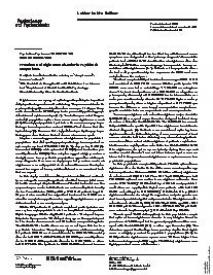Prevalence of Nightmare Disorder in Psychiatric Outpatients
Nightmares can cause great suffering as they disturb sleep, affect
daily functioning and overall well-being. They are associated with
psychopathology like anxiety disorders, more specifically posttraumatic
stress disorder (PTSD), psychosis, personality pathology, suicide
risk, and substance abuse [1, 2] . Two to five percent of the general
adult population suffers from one or more nightmares a week
[3, 4] . One study of psychiatric patients with more severe psychopathology
showed a prevalence rate of 39.8% of ‘bad dreams that disturbed
sleep’ [5] . However, this study did not specify the psychopathology
nor describe how the bad dreams where measured.
Studies concerning prevalence of nightmares in psychiatric
populations that did specify psychopathology have reported on
subsamples such as: PTSD 50–70% [1, 2] , depression 17.5% [6] ,
insomnia 18.3% [7] , schizophrenia 16.7% [6] , and borderline personality
disorder 49% [8] . These studies suggest a high prevalence
of nightmares in a psychiatric population, regardless of the primary
diagnosis. However, no study reported prevalence rates of
nightmares across all psychiatric disorders. Moreover, the studies
cannot be compared because of the different assessment methods
that were used.
Geachte bezoeker,
De informatie die u nu opvraagt, kan door psychotraumanet niet aan u worden getoond. Dit kan verschillende redenen hebben,
waarvan (bescherming van het) auteursrecht de meeste voorkomende is. Wanneer het mogelijk is om u door te verwijzen naar de bron
van deze informatie, dan ziet u hier onder een link naar die plek.
Als er geen link staat, kunt u contact opnemen met de bibliotheek,
die u verder op weg kan helpen.
Met vriendelijke groet,
Het psychotraumanet-team.
Reference:
Marijke L. Swart, Annette M. van Schagen, Jaap Lancee, Jan van den Bout | 2013
In: Psychotherapy and psychosomatics : international journal of psychotherapy and psychosomatics : official organ of the International Federation for Medical Psychotherapy, ISSN 0033-3190 | 82 | 4 | 267-268
https://www.karger.com/Article/Abstract/343590
In: Psychotherapy and psychosomatics : international journal of psychotherapy and psychosomatics : official organ of the International Federation for Medical Psychotherapy, ISSN 0033-3190 | 82 | 4 | 267-268
https://www.karger.com/Article/Abstract/343590


